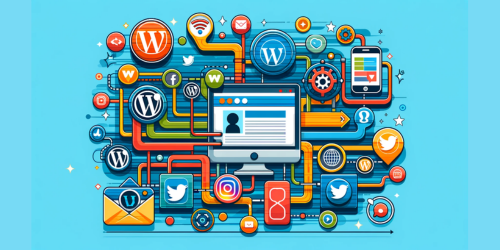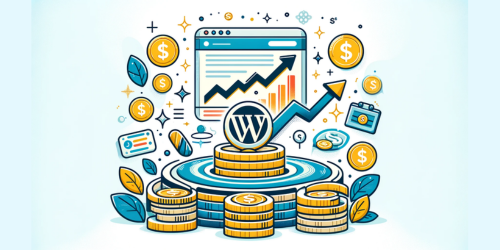As the most popular content management system (CMS) on the internet, WordPress is a prime target for hackers looking to exploit security vulnerabilities.
Whether you’re running a small blog or a large business website, it’s essential to take steps to keep your site safe from malicious attacks.
In this article, we’ll outline some best practices and tips on WordPress Security for keeping your site secure.
1. Keep Your WordPress Site Updated
One of the most critical steps in securing your WordPress site is to keep it updated. This means not only updating WordPress core but also themes and plugins. Outdated software can contain security vulnerabilities that hackers can exploit to gain access to your site.
Keeping everything updated ensures that you have the latest security patches and bug fixes.
When a new version of WordPress, a theme, or a plugin is available, update it as soon as possible.
WordPress will alert you in your dashboard when an update is available. You can also set up automatic updates for WordPress and plugins using a plugin like Easy Updates Manager.
2. Use Strong Passwords
Passwords are the first line of defense against unauthorized access to your site. A weak password can make it easy for hackers to guess or brute-force their way in. It’s recommended to use a password manager to generate strong, unique passwords for each of your accounts, and make sure to enable two-factor authentication wherever possible.
Avoid using common words or phrases as passwords. Instead, use a mix of upper and lowercase letters, numbers, and symbols. It’s also important to change your passwords regularly, ideally every three months.
3. Limit Login Attempts
Another way to protect your WordPress site is to limit the number of login attempts. By default, WordPress allows unlimited login attempts, making it easy for hackers to use brute-force attacks to guess your password.
You can use plugins like Login Lockdown or Limit Login Attempts to restrict the number of login attempts and block IP addresses after a certain number of failed attempts.
These plugins limit the number of login attempts by IP address or username so that any attempts beyond the limit will be blocked. This makes it harder for hackers to guess passwords and gain access to your site.
4. Use a Web Application Firewall (WAF)
A web application firewall (WAF) can help protect your site from malicious traffic and attacks. A WAF sits between your site and the internet, filtering out malicious requests and blocking them before they can reach your site. Popular WAF solutions for WordPress include Cloudflare and Sucuri.
WAFs use a set of rules to identify and block suspicious traffic. They can also protect against DDoS attacks and other types of malicious traffic that can overload your server and take down your site. They are particularly useful for large or high-traffic areas that are at greater risk of attacks.
5. Disable File Editing
By default, WordPress allows you to edit plugin and theme files directly from the dashboard. While this can be convenient for making quick changes, it also poses a security risk. If a hacker gains access to your site, they can use this feature to insert malicious code into your site.
You can disable file editing by adding the following code to your wp-config.php file:
define('DISALLOW_FILE_EDIT', true);This will disable the file editor in WordPress, preventing anyone from making changes to your site’s files from within the dashboard. If you need to make changes to your site’s files, you can do so using FTP or a file manager.
7. Keep Backups
Backing up your site regularly is essential in case of a security breach. If your site is compromised, having a recent backup can make it easier to restore your site to its previous state. You can use a plugin like UpdraftPlus to automate backups and store them on an external service like Google Drive or Dropbox.
It’s important to test your backups regularly to make sure they can be successfully restored. You should also store backups in a secure location and ensure that only authorized users have access to them.
8. Monitor for Suspicious Activity
Monitoring your site for suspicious activity can help you detect and respond to security breaches quickly. You can use plugins like Wordfence or iThemes Security to scan your site for malware, check for vulnerabilities, and monitor login attempts.
These plugins can also send you alerts if they detect any suspicious activity on your site, such as failed login attempts or unauthorized file changes. This can help you take action before a security breach occurs.
9. Use Strong File Permissions
File permissions determine who can read, write, or execute files on your server. Setting strong file permissions can help prevent unauthorized access to your site’s files. WordPress requires specific file permissions to function correctly, and changing them can cause issues.
However, you can use a plugin like iThemes Security to harden your file permissions and protect your site from common attacks.
10. Use a Reliable Hosting Provider
The quality of your web hosting can also affect the security of your site. A reliable hosting provider will have measures in place to protect against DDoS attacks, malware, and other security threats. They will also provide regular backups, security updates, and technical support in case of a security breach.
Choose a hosting provider with a good reputation and a track record of providing reliable and secure hosting services. Some popular options for WordPress hosting include SiteGround, Bluehost, and WP Engine.
11. Limit User Access
Limiting user access to your site is another important security measure. You can create multiple users accounts with different levels of access to your site’s backend, so that only authorized users can make changes to your site.
For example, you might have an editor who can create and publish posts but doesn’t have access to your site’s plugins or settings. You can use a plugin like User Role Editor to create custom roles and set permissions for each user.
12. Disable XML-RPC
XML-RPC is a protocol that allows remote access to your WordPress site. However, it’s also a common target for brute-force attacks and DDoS attacks. Disabling XML-RPC can help prevent these types of attacks, and can also improve your site’s performance.
You can disable XML-RPC by adding a few lines of code to your site’s functions.php file, or by using a plugin like Disable XML-RPC.
Add_filter( ‘xmlrpc_enabled’, ‘__return_false’ );
13. Use Two-Factor Authentication
Two-factor authentication (2FA) adds an extra layer of security to your login process. With 2FA, users must enter a second form of identification, such as a one-time code sent to their phone, in addition to their username and password.
You can enable 2FA on your site using a plugin like Google Authenticator or Authy. This can help prevent unauthorized access to your site, even if your password is compromised.
14. Use a Content Delivery Network (CDN)
A content delivery network (CDN) can improve your site’s performance and security by caching your site’s content on servers around the world. This can help reduce the load on your server and prevent DDoS attacks.
You can use a CDN service like Cloudflare or MaxCDN to improve your site’s performance and security.
15. Remove Unused Themes and Plugins
Unused themes and plugins can pose a security risk to your site, even if they’re not active. Outdated or vulnerable code can be exploited by hackers to gain access to your site or install malware.
It’s important to remove any themes or plugins that you’re not using and to keep the ones you are using up-to-date. You can also use a plugin like WPScan to scan your site for vulnerable themes and plugins.
16. Monitor File Changes
Monitoring file changes on your WordPress site can help you detect suspicious activity and unauthorized access. You can use a plugin like Wordfence or iThemes Security to monitor file changes and receive alerts when files are modified.
17. WordPress security: Keep Your Site Up-to-Date
Keeping your WordPress site up-to-date is crucial for security. WordPress releases regular updates that include security patches and bug fixes, and it’s important to install them as soon as they become available.
You should also keep your themes and plugins up-to-date, as outdated or vulnerable code can be exploited by hackers.
18. Use SSL Encryption
Using SSL encryption can help secure your site and protect your users’ data. SSL encrypts the connection between your site and your users’ browsers, preventing third parties from intercepting sensitive information like passwords and credit card numbers.
You can use a free SSL certificate from Let’s Encrypt, or purchase one from a trusted certificate authority.
19. Conclusion
Securing your WordPress site requires a multi-layered approach that includes updating software, using strong passwords, limiting login attempts, using a WAF, disabling file editing, and more.
By following these best practices and using the right plugins, you can help protect your site from malicious attacks and keep your data safe.
20. FAQs:
How do I make my WordPress site more secure?
To enhance WordPress security, use strong passwords, keep WordPress, themes, and plugins updated, limit login attempts, and implement security plugins like Wordfence or Sucuri.
How do I secure my WordPress site for free?
Secure your WordPress site for free by using security plugins like Wordfence Security, setting up two-factor authentication, and regularly updating and backing up your site.
What is the best security for WordPress?
The best security for a WordPress site often involves a combination of practices, including using reputable security plugins like Wordfence or Sucuri, implementing SSL certificates, and adhering to WordPress hardening techniques.
How to make your website secure?
To make your website secure, use HTTPS with an SSL certificate, keep all software up to date, use strong passwords and proper file permissions, and regularly scan for vulnerabilities.



